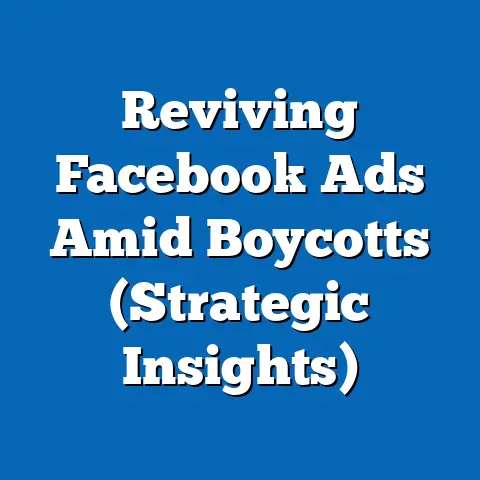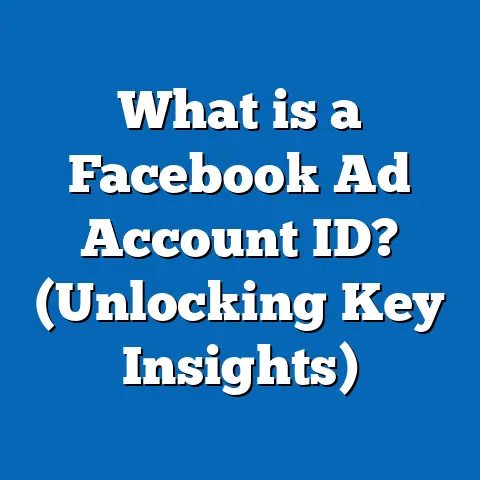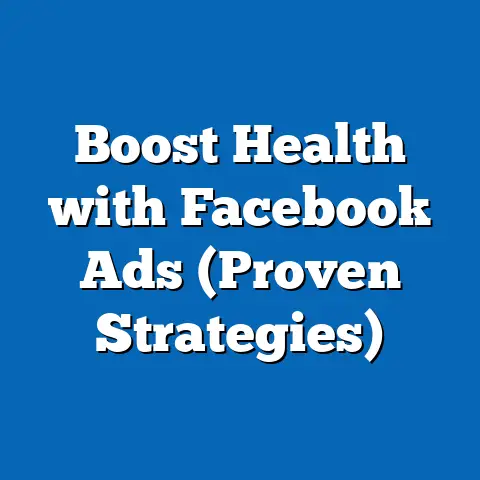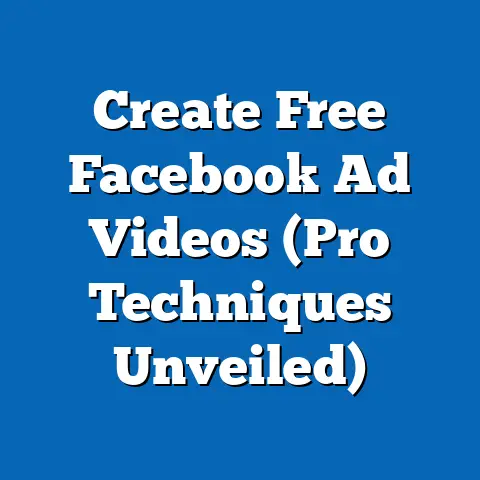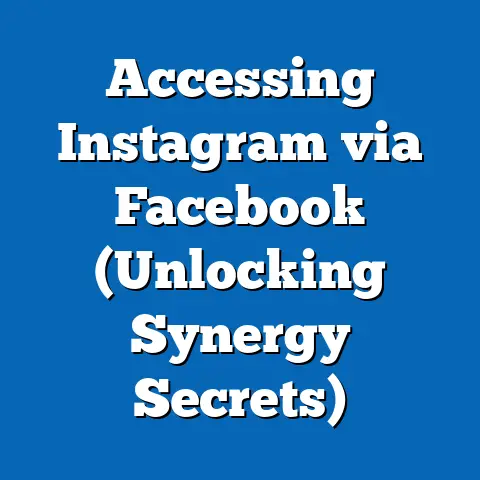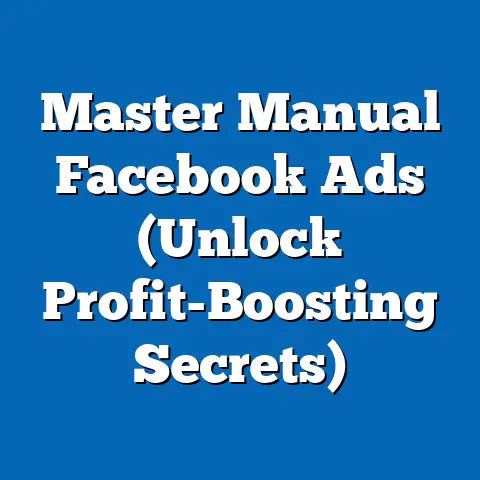Boost Affiliates with Facebook Ads (Proven Strategies)
I remember the early days of my affiliate marketing journey like it was yesterday. I was fresh out of college, brimming with enthusiasm, but severely lacking in practical experience. I stumbled upon the concept of affiliate marketing and was immediately captivated by the idea of earning passive income by promoting other people’s products. I built a website, filled it with content, and waited for the magic to happen. And waited. And waited.
Traffic was trickling in, but sales were nonexistent. Frustration mounted. I knew I had a good niche and decent content, but nobody was seeing it. That’s when I decided to take a leap of faith and dive into the world of Facebook Ads. Honestly, it felt like throwing money into a black hole at first. My initial campaigns were poorly targeted, my ad copy was bland, and my visuals were… well, let’s just say they wouldn’t win any design awards.
But I didn’t give up. I devoured every article, every tutorial, every webinar I could find on Facebook Ads. I experimented with different targeting options, honed my ad copy, and invested in better visuals. Slowly but surely, I started seeing results. My traffic increased, my conversion rates improved, and my affiliate income began to climb.
Facebook Ads became my secret weapon, transforming my struggling affiliate business into a thriving enterprise. And that’s what I want to share with you today. In this article, I’ll reveal the proven strategies that helped me leverage Facebook Ads to drive conversions and skyrocket my affiliate revenue. Whether you’re a seasoned affiliate marketer or just starting out, these insights can help you unlock the immense potential of Facebook Ads and take your business to the next level.
Understanding Facebook Ads and Their Importance in Affiliate Marketing
So, what exactly are Facebook Ads? In its simplest form, Facebook Ads is a paid advertising platform that allows you to display your ads to a highly targeted audience on Facebook and its related platforms, including Instagram, Messenger, and the Audience Network. Instead of waiting for organic reach, Facebook Ads allow you to pay for visibility, putting your offer in front of the right people at the right time.
For affiliate marketers, Facebook Ads offer a unique set of advantages that can be a total game-changer:
- Precise Targeting: This is arguably the biggest strength of Facebook Ads. You can target users based on demographics (age, gender, location), interests, behaviors, and even custom audiences based on your existing customer data. This level of granularity allows you to reach precisely the people who are most likely to be interested in the products you’re promoting.
- Cost-Effectiveness: Compared to other advertising platforms like traditional media or even Google Ads in some niches, Facebook Ads can be surprisingly cost-effective. You have full control over your budget and can start with as little as $5 per day. The key is to test and optimize your campaigns to maximize your ROI.
- Scalability: Once you find a winning formula, Facebook Ads allow you to scale your campaigns quickly and easily. You can increase your budget, expand your targeting, and reach a wider audience with just a few clicks.
- High ROI Potential: When done right, Facebook Ads can deliver a significantly high return on investment. By targeting the right audience with the right message, you can drive a steady stream of qualified leads and conversions to your affiliate offers.
Don’t just take my word for it. According to Statista, Facebook’s ad revenue continues to climb year after year, demonstrating its effectiveness as an advertising platform. Moreover, numerous case studies highlight the success of affiliate marketers using Facebook Ads. For example, I’ve seen examples of affiliate marketers generating 5x, 10x, or even 20x ROI on their Facebook Ads campaigns by promoting high-converting offers to highly targeted audiences.
Key Takeaway: Facebook Ads provide unparalleled targeting capabilities, cost-effectiveness, and scalability, making them a powerful tool for affiliate marketers looking to drive traffic and increase revenue.
Setting Up Your Facebook Ads for Success
Before you start throwing money at Facebook Ads, it’s crucial to lay a solid foundation for your campaigns. This involves setting up your account correctly, defining your target audience, and crafting compelling ads that grab attention and drive clicks.
1. Creating Your Facebook Ads Account and Navigating Ads Manager:
If you don’t already have one, you’ll need to create a Facebook Business Manager account. This is a central hub for managing all your Facebook marketing activities, including your ad accounts, pages, and pixels. Once you’ve created your Business Manager account, you can create an ad account within it.
The Facebook Ads Manager is your command center for creating, managing, and analyzing your ad campaigns. It can seem overwhelming at first, but it’s actually quite intuitive once you get the hang of it. The main sections you’ll be using are:
- Campaigns: This is where you set your overall campaign objective, such as driving website traffic, generating leads, or increasing conversions.
- Ad Sets: This is where you define your target audience, set your budget, and choose your ad placements (e.g., Facebook feed, Instagram stories, Audience Network).
- Ads: This is where you create your individual ads, including choosing your ad format, writing your ad copy, and selecting your visuals.
2. Defining Your Target Audience with Facebook Audience Insights:
One of the most critical steps in setting up your Facebook Ads campaigns is defining your target audience. Who are you trying to reach? What are their interests, demographics, and behaviors?
Facebook’s Audience Insights tool is an invaluable resource for answering these questions. It allows you to explore the demographics, interests, behaviors, and page likes of people on Facebook. You can use this data to create highly targeted audiences for your ads.
For example, let’s say you’re promoting a weight loss product. You might use Audience Insights to identify people who are interested in fitness, healthy eating, and weight loss. You could also target people who have liked pages related to these topics.
3. Crafting Compelling Ads:
Once you’ve defined your target audience, it’s time to create ads that grab their attention and entice them to click. Here are a few key elements of effective Facebook Ads:
- Ad Format: Facebook offers a variety of ad formats, including image ads, video ads, carousel ads, and collection ads. Choose the format that best suits your product and target audience. I’ve found that video ads tend to perform exceptionally well, especially for demonstrating product features or sharing testimonials. Carousel ads are great for showcasing multiple products or features.
- Ad Copy: Your ad copy should be clear, concise, and compelling. Highlight the benefits of your product and include a strong call to action. Use persuasive language and address the pain points of your target audience. Don’t be afraid to inject some personality into your copy to make it stand out.
- Visuals: Your visuals are just as important as your ad copy. Use high-quality images or videos that are visually appealing and relevant to your product. Make sure your visuals are optimized for mobile devices, as most Facebook users access the platform on their phones.
- Call to Action (CTA): Every ad should have a clear call to action that tells users what you want them to do. Use action-oriented verbs like “Shop Now,” “Learn More,” “Sign Up,” or “Get Started.”
4. Setting Your Budget and Bidding Strategy:
Facebook offers two main budget options: daily budget and lifetime budget. A daily budget allows you to set a specific amount you’re willing to spend each day, while a lifetime budget allows you to set a total amount you’re willing to spend over the entire duration of your campaign.
There are also several bidding strategies to choose from, including:
- Lowest Cost: Facebook will automatically bid to get you the most results for your budget.
- Cost Cap: You set a target cost per result, and Facebook will try to stay within that limit.
- Bid Cap: You set a maximum bid you’re willing to pay for each auction.
For affiliate marketers, I generally recommend starting with a daily budget and the “Lowest Cost” bidding strategy. This allows you to get a feel for how your ads are performing and make adjustments as needed. Once you have a better understanding of your target audience and ad performance, you can experiment with other bidding strategies.
Key Takeaway: Setting up your Facebook Ads for success involves creating a properly configured ad account, defining your target audience using Audience Insights, crafting compelling ads with engaging visuals and persuasive copy, and setting a budget and bidding strategy that aligns with your goals.
Proven Strategies to Boost Affiliate Sales with Facebook Ads
Now comes the fun part: implementing proven strategies to drive affiliate sales with Facebook Ads. These strategies are based on my own experience and the experiences of other successful affiliate marketers.
Strategy 1: Leveraging Retargeting
Retargeting is one of the most powerful tools in the Facebook Ads arsenal. It allows you to show ads to people who have previously interacted with your website or Facebook page. These people are already familiar with your brand and products, making them much more likely to convert.
For example, you can retarget people who have visited your website but didn’t make a purchase, people who have added a product to their cart but didn’t complete the checkout process, or people who have watched a certain percentage of your video.
To implement retargeting, you’ll need to install the Facebook Pixel on your website. The Pixel is a small piece of code that tracks the actions of visitors to your website. Once the Pixel is installed, you can create custom audiences based on these actions and target them with your ads.
I’ve personally seen retargeting campaigns generate significantly higher conversion rates and ROI compared to cold traffic campaigns. It’s a must-have strategy for any affiliate marketer using Facebook Ads.
Strategy 2: Creating Engaging Content
In today’s crowded online landscape, it’s not enough to simply promote products. You need to create valuable content that resonates with your audience and builds trust. This could include:
- Reviews: Honest and unbiased reviews of the products you’re promoting.
- Tutorials: Step-by-step guides on how to use the products you’re promoting.
- Comparisons: Side-by-side comparisons of different products in the same niche.
- Blog Posts: Informative and engaging blog posts that address the pain points of your target audience.
By creating valuable content, you can establish yourself as an authority in your niche and build a loyal following. This will not only increase your affiliate sales but also improve your overall brand reputation.
Strategy 3: Utilizing Lookalike Audiences
Lookalike Audiences allow you to reach new people who are similar to your existing customers or website visitors. Facebook uses its vast database of user data to identify people who share similar demographics, interests, and behaviors with your source audience.
For example, you can create a Lookalike Audience based on your existing customer list or your website visitors. Facebook will then find people who are similar to these individuals and target them with your ads.
I’ve found that Lookalike Audiences are a great way to expand your reach and find new customers who are likely to be interested in your products.
Strategy 4: Testing and Optimizing Your Ads
The key to success with Facebook Ads is continuous testing and optimization. You should never assume that your initial ads are perfect. Instead, you should constantly be testing different ad elements, such as:
- Headlines: Try different headlines to see which ones generate the most clicks.
- Images: Test different images to see which ones are the most visually appealing.
- Call-to-Action Buttons: Experiment with different call-to-action buttons to see which ones drive the most conversions.
- Targeting Options: Test different targeting options to see which ones reach the most qualified leads.
Facebook Ads Manager provides detailed analytics that allow you to track the performance of your ads. Pay attention to metrics like click-through rate (CTR), cost per click (CPC), and conversion rate. Use this data to make informed decisions about which ads to keep running and which ones to pause or modify.
I typically use A/B testing to compare two versions of an ad, changing only one element at a time. This allows me to isolate the impact of each element and make data-driven decisions.
Key Takeaway: Implement retargeting campaigns to re-engage warm leads, create engaging content to build trust and authority, utilize Lookalike Audiences to expand your reach, and continuously test and optimize your ads to improve performance.
Common Mistakes to Avoid
Even with the best strategies, it’s easy to make mistakes when running Facebook Ads campaigns. Here are a few common pitfalls to avoid:
- Poor Targeting: Targeting the wrong audience is one of the most common mistakes. Make sure you’ve thoroughly researched your target audience and are using the right targeting options.
- Bland Ad Copy: Generic or uninspired ad copy will fail to grab attention. Make sure your ad copy is clear, concise, and compelling.
- Low-Quality Visuals: Blurry or unprofessional visuals will turn people off. Use high-quality images or videos that are visually appealing.
- Not Tracking Conversions: If you’re not tracking conversions, you won’t know which ads are working and which ones aren’t. Make sure you’ve installed the Facebook Pixel and are tracking your conversions.
- Giving Up Too Soon: It takes time to optimize your Facebook Ads campaigns. Don’t give up after just a few days. Give your ads enough time to generate data and make adjustments as needed.
I’ve made my fair share of mistakes over the years. I remember one campaign where I was targeting a broad audience with a generic ad. I was getting a lot of clicks, but very few conversions. It wasn’t until I narrowed down my targeting and rewrote my ad copy that I started seeing results. The lesson I learned was that attention to detail and continuous optimization are essential for success.
Key Takeaway: Avoid common mistakes like poor targeting, bland ad copy, low-quality visuals, and failing to track conversions. Be patient and persistent, and don’t give up too soon.
Conclusion
Facebook Ads can be a powerful tool for affiliate marketers looking to drive traffic, generate leads, and increase revenue. By understanding the platform, defining your target audience, crafting compelling ads, and implementing proven strategies like retargeting, creating engaging content, utilizing Lookalike Audiences, and continuously testing and optimizing your ads, you can unlock the immense potential of Facebook Ads and take your affiliate business to the next level.
I’ve seen firsthand the transformative power of Facebook Ads. It’s not a magic bullet, but with the right approach, it can be a game-changer. My journey started with frustration and uncertainty, but through continuous learning and experimentation, I was able to turn Facebook Ads into a reliable source of income.
Now, it’s your turn. Take the strategies outlined in this article and start experimenting with your own Facebook Ads campaigns. Don’t be afraid to make mistakes. Learn from them and keep iterating. With patience, persistence, and a willingness to learn, you can achieve your affiliate marketing goals with Facebook Ads. Good luck, and happy advertising!

